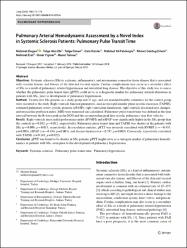| dc.contributor.author | Doğan, Mehmet | |
| dc.contributor.author | Efe, Tolga Han | |
| dc.contributor.author | Çimen, Tolga | |
| dc.contributor.author | Özişler, Cem | |
| dc.contributor.author | Felekoğlu, Mehmet Ali | |
| dc.contributor.author | Ertem, Ahmet Göktuğ | |
| dc.contributor.author | Erat, Mehmet | |
| dc.contributor.author | Yiǧiner, Ömer | |
| dc.contributor.author | Tulmaç, Murat | |
| dc.date.accessioned | 10.07.201910:49:13 | |
| dc.date.accessioned | 2019-07-10T19:50:46Z | |
| dc.date.available | 10.07.201910:49:13 | |
| dc.date.available | 2019-07-10T19:50:46Z | |
| dc.date.issued | 2018 | en_US |
| dc.identifier.citation | Doğan, M., Efe, T. H., Çimen, T., Özişler, C., Felekoğlu, M. A., Ertem, A. G. ... Tulmaç, M. (2018). Pulmonary arterial hemodynamic assessment by a novel ındex in systemic sclerosis patients: Pulmonary pulse transit time. Lung, 196(2), 173-178. https://dx.doi.org/10.1007/s00408-018-0098-6 | en_US |
| dc.identifier.issn | 0341-2040 | |
| dc.identifier.issn | 1432-1750 | |
| dc.identifier.uri | https://dx.doi.org/10.1007/s00408-018-0098-6 | |
| dc.identifier.uri | https://hdl.handle.net/20.500.12511/2070 | |
| dc.description | WOS: 000427629200006 | en_US |
| dc.description | PubMed ID: 29445936 | en_US |
| dc.description.abstract | Systemic sclerosis (SSc) is a chronic, inflammatory, and autoimmune connective tissue disease that is associated with vascular lesions, and fibrosis of the skin and visceral organs. Cardiac complications may occur as a secondary effect of SSc as a result of pulmonary arterial hypertension and interstitial lung disease. The objective of this study was to assess whether the pulmonary pulse transit time (pPTT) could serve as a diagnostic marker for pulmonary arterial alterations in patients with SSc, prior to development of pulmonary hypertension. Twenty-five SSc patients as a study group and 25 age- and sex-matched healthy volunteers for the control group were recruited to the study. Right ventricle function parameters, such as tricuspid annular plane systolic excursion (TAPSE), estimated pulmonary artery systolic pressure (ePASP), right ventricular dimensions, right ventricle fractional area changes, and myocardial perfusion index (MPI) were measured and calculated. Pulmonary pulse transit time was defined as the time interval between the R-wave peak in the ECG and the corresponding peak late systolic pulmonary vein flow velocity. Right ventricle myocardial performance index (RVMPI) and eSPAP were significantly higher in the SSc group than the controls (p = 0.032, p = 0.012, respectively). Pulmonary pulse transit time and TAPSE was shorter in the patients with SSc (p = 0.006, p = 0.015, respectively). In correlation analysis, pPTT was inversely correlated with RVMPI (r = - 0.435, p = 0.003), eSPAP (r = - 0.434, p = 0.003), and disease duration (r = - 0.595, p = 0.003). Conversely, it positively correlated with TAPSE (r = 0.345, p = 0.022). pPTT was found to be shorter in SSc patients. pPTT might serve as a surrogate marker of pulmonary hemodynamics in patients with SSc, even prior to the development of pulmonary hypertension. | en_US |
| dc.language.iso | eng | en_US |
| dc.publisher | Springer | en_US |
| dc.rights | info:eu-repo/semantics/embargoedAccess | en_US |
| dc.subject | Systemic Sclerosis | en_US |
| dc.subject | Pulmonary Pulse Transit Time | en_US |
| dc.subject | Pulmonary Hypertension | en_US |
| dc.title | Pulmonary arterial hemodynamic assessment by a novel ındex in systemic sclerosis patients: Pulmonary pulse transit time | en_US |
| dc.type | article | en_US |
| dc.relation.ispartof | Lung | en_US |
| dc.department | İstanbul Medipol Üniversitesi, Tıp Fakültesi, Dahili Tıp Bilimleri Bölümü, Kardiyoloji Ana Bilim Dalı | en_US |
| dc.authorid | 0000-0002-5794-9730 | en_US |
| dc.identifier.volume | 196 | en_US |
| dc.identifier.issue | 2 | en_US |
| dc.identifier.startpage | 173 | en_US |
| dc.identifier.endpage | 178 | en_US |
| dc.relation.publicationcategory | Makale - Uluslararası Hakemli Dergi - Kurum Öğretim Elemanı | en_US |
| dc.identifier.doi | 10.1007/s00408-018-0098-6 | en_US |
| dc.identifier.wosquality | Q3 | en_US |
| dc.identifier.scopusquality | Q2 | en_US |


















